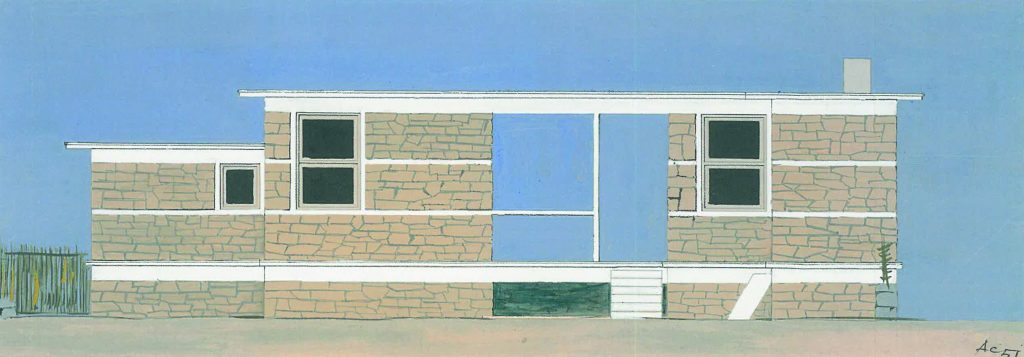This small holiday home in Sykiá, a few kilometres from Xilókastro, along the road between Corinth and Patras, is among the works by Konstantinidis that have received unanimous critical acclaim in Greece and abroad. After the successful work for Lambros Eftaxias in Eleusis (1938) and the flat on the terrace of the painter Mavroidis (1949-51), the house in Sykiá is the first example of what can be defined as the “poetic elaboration of the anonymous”. Built on a small triangular lot wedged between the beach and the road, it translates, with ancient sensibility and personal language, the essence of living. The house is made up of two volumes, rotated 90° from each other and separated in the centre by a void, covered by the roof and designed by fine balustrades: the hypostyle. The living room and kitchen are located on the short side of the lot, while the bedroom and bathroom are arranged on the long side parallel to the sea.
Esta pequeña casa de vacaciones en Sykiá, a pocos kilómetros de Xilókastro, a lo largo de la carretera entre Corinto y Patras, figura entre las obras de Konstantinidis que han recibido el aplauso unánime de la crítica en Grecia y en el extranjero. Tras la exitosa obra para Lambros Eftaxias en Eleusis (1938) y el piso en la terraza del pintor Mavroidis (1949-51), la casa de Sykiá es el primer ejemplo de lo que puede definirse como la “elaboración poética de lo anónimo”. Construida en un pequeño solar triangular encajonado entre la playa y la carretera, traduce, con sensibilidad antigua y lenguaje personal, la esencia del vivir. La casa se compone de dos volúmenes, girados 90° entre sí y separados en el centro por un vacío, cubierto por el tejado y diseñado por finas balaustradas: la hipóstila. El salón y la cocina se sitúan en el lado corto de la parcela, mientras que el dormitorio y el cuarto de baño se disponen en el lado largo paralelo al mar.



As is common in the spontaneous architecture of these areas, Sykiá’s rooms have windows on both the north and south sides, to circulate the air in summer and keep the internal temperature down. Konstantinidis notes that in areas of the Peloponnese with high seismicity, stone clad with clay kerbstones has been used for centuries: from this lesson in construction comes the decision to frame the openings and space the layers of stone (80 x 50 cm) with concrete kerbstones, cast on site and painted white. What appears to be a figurative choice is above all the precaution of a good master builder. But the key to understanding this house lies in its relationship between the interior and the portico: as in the old megaron, as in the traditional house and in the anonymous one, the Sykiá portico corresponds to the place of mediation between the room and the courtyard, between shadow and light, it is the limit “from which a thing begins its essence”. It is within this limit that the inhabitant places himself to welcome the revelation of the surrounding landscape, the sea and the land, to “marvel at the simple and […] dwell in this marvel”.
Como es habitual en la arquitectura espontánea de estas zonas, las habitaciones de Sykiá tienen ventanas tanto en el lado norte como en el sur, para hacer circular el aire en verano y mantener baja la temperatura interior. Konstantinidis señala que en las zonas del Peloponeso con alta sismicidad se ha utilizado durante siglos la piedra revestida con bordillos de arcilla: de esta lección de construcción procede la decisión de enmarcar las aberturas y espaciar las capas de piedra (80 x 50 cm) con bordillos de hormigón, moldeados in situ y pintados de blanco. Lo que parece una elección figurativa es ante todo la precaución de un buen maestro de obras. Pero la clave para entender esta casa reside en su relación entre el interior y el pórtico: como en el antiguo megaron, como en la casa tradicional y en la anónima, el pórtico de Sykiá corresponde al lugar de mediación entre la habitación y el patio, entre la sombra y la luz, es el límite “a partir del cual una cosa comienza su esencia”. Es en este límite donde el habitante se sitúa para acoger la revelación del paisaje circundante, el mar y la tierra, para “maravillarse de lo sencillo y […] habitar en esta maravilla”.
Text via Aris Konstantinidis 1913-1993. Paola Cofano and Dimitri Konstantinidis, Electa. Translation by Hidden Architecture





